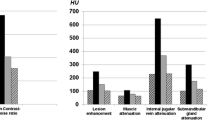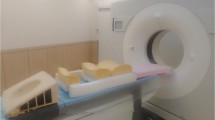Abstract
Purpose
To evaluate the image quality and lesion visibility of virtual monoenergetic images (VMIs) reconstructed using a new monoenergetic reconstruction algorithm (nMERA) for evaluation of breast cancer.
Materials and methods
Forty-two patients with 46 breast cancers who underwent 4-phasic breast contrast-enhanced computed tomography (CT) using dual-energy CT (DECT) were enrolled. We selected the peak enhancement phase of the lesion in each patient. The selected phase images were generated by 120-kVp-equivalent linear blended (M120) and monoenergetic reconstructions from 40 to 80 keV using the standard reconstruction algorithm (sMERA: 40, 50, 60, 70, 80) and nMERA (40 +, 50 +, 60 +, 70 +, 80 +). The contrast-to-noise ratio (CNR) was calculated and objectively analyzed. Two independent readers subjectively scored tumor visibility and image quality each on a 5-point scale.
Results
The CNR at 40 + and tumor visibility scores at 40 + and 50 + were significantly higher than those on M120. The CNR at 50 + was not significantly different from that on M120. However, the overall image quality score at 40 + was significantly lower than that at 50 + and on M120 (40 + vs M120, P < 0.0001 and 40 + vs 50 +, P = 0.0001).
Conclusions
VMI reconstructed with nMERA at 50 keV is preferable for evaluation of patients with breast cancer.



Similar content being viewed by others
References
Jemal A, Siegel R, Xu J, Ward E. Cancer statistics, 2010. Cancer J Clin. 2010;60:277–300.
Anscher MS, Jones P, Prosnitz LR, Blackstock W, Hebert M, Reddick R, et al. Local failure and margin status in early-stage breast carcinoma treated with conservation surgery and radiation therapy. Ann Surg. 1993;218:22–8.
Fortin A, Larochelle M, Laverdiere J, Lavertu S, Tremblay D. Local failure is responsible for the decrease in survival for patients with breast cancer treated with conservative surgery and postoperative radiotherapy. J Clin Oncol. 1999;17:101–9.
Ahn SJ, Kim YS, Kim EY, Park HK, Cho EK, Kim YK, et al. The value of chest CT for prediction of breast tumor size: comparison with pathology measurement. World J Surg Oncol. 2013;11:130.
Goto M, Ito H, Akazawa K, Kubota T, Kizu O, Yamada K, et al. Diagnosis of breast tumors by contrast-enhanced MR imaging: comparison between the diagnostic performance of dynamic enhancement patterns and morphologic features. J Magn Reson Imaging. 2007;25:104–12.
Weinstein SP, Hanna LG, Gatsonis C, Schnall MD, Rosen MA, Lehman CD. Frequency of malignancy seen in probably benign lesions at contrast-enhanced breast MR imaging: findings from ACRIN 6667. Radiology. 2010;255:731–7.
Kuhl C, Weigel S, Schrading S, Arand B, Bieling H, Konig R, et al. Prospective multicenter cohort study to refine management recommendations for women at elevated familial risk of breast cancer: the EVA trial. J Clin Oncol. 2010;28:1450–7.
Lorenzon M, Zuiani C, Linda A, Londero V, Girometti R, Bazzocchi MI. Magnetic resonance imaging in patients with nipple discharge: should we recommend it? Eur Radiol. 2011;21:899–907.
Shimauchi A, Yamada T, Sato A, Takase K, Usami S, Ishida T, et al. Comparison of MDCT and MRI for evaluating the intraductal component of breast cancer. AJR Am J Roentgenol. 2006;187:322–9.
Uematsu T, Yuen S, Kasami M, Uchida Y. Comparison of magnetic resonance imaging, multidetector row computed tomography, ultrasonography, and mammography for tumor extension of breast cancer. Breast Cancer Res Treat. 2008;112:461–74.
Igarashi T, Tozaki M, Fukuda K. Evaluation of the extent of ductal carcinoma in situ: comparison of MDCT and high-spatial-resolution MR imaging. Nihon Igaku Hoshasen Gakkai Zasshi. 2005;65:387–92.
Prrone A, Lo Mele L, Sassi S, Marini M, Testaverde L, Izzo L, et al. MDCT of the breast. AJR Am J Roentgenol. 2008;190:1644–51.
Uematsu T. Comparison of magnetic resonance imaging and multidetector computed tomography for evaluating intraductal tumor extension of breast cancer. Jpn J Radiol. 2010;28:563–70.
Weidner N, Folkman J, Pozza F, Bevillacqua P, Allred EN, Moore DH, et al. Tumor angiogenesis: a new significant and independent prognostic indicator in early-stage breast carcinoma. J Natl Cancer Inst. 1992;84:1875–87.
Frouge C, Guinebretiere JM, Contesso G, Di Paola R, Blery M. Correlation between contrast enhancement in dynamic magnetic resonance imaging of the breast and tumor angiogenesis. Invest Radiol. 1994;29:1043–9.
Sudarski S, Apfaltrer P, Nance JW Jr, Meyer M, Fink C, Hohenberger P, et al. Objective and subjective image quality of liver parenchyma and hepatic metastases with virtual monoenergetic dual-source dual-energy CT reconstructions: an analysis in patients with gastrointestinal stromal tumor. Acad Radiol. 2014;214:514–22.
Grant KL, Flour TG, Krauss B, Sedimair M, Thormas C, Schmidt B. Assessment of an advanced image-based technique to calculate virtual monoenergetic computed tomographic images from a dual-energy examination to improve contrast-to-noise ratio in examinations using iodinated contrast media. Invest Radiol. 2014;49:586–92.
Matsuda M, Tsuda T, Kido T, Tanaka H, Nishiyama H, Itoh T, et al. Dual-energy computed tomography in patients with small hepatocellular carcinoma: utility of noise-reduced monoenergetic images for the evaluation of washout and image quality in the equilibrium phase. J Comput Assist Tomogr. 2018;42:937–43.
Yao Y, Nagasawa A, Kakegawa A, Kato M, Kaisaki S, Sakatani T. An attempt to evaluate intraductal components of breast cancer by dual energy computed tomography. Imaging Med. 2018;10:103–10.
Metin Y, Metin NO, Ozdemir O, Tasci F, Kul S. The role of low keV virtual monochromatic imaging in increasing the conspicuity of primary breast cancer in dual-energy spectral thoracic CT examination for staging purposes. Acta Radiol. 2019. https://doi.org/10.1177/0284185119858040.
Lenga L, Czwikla R, Wichmann JL, Leithner D, Albrecht MH, D’Angelo T, et al. Dual-energy CT in patients with abdominal malignant lymphoma: impact of noise-optimised virtual monoenergetic imaging on objective and subjective image quality. Clin Radiol. 2018;73(833):e19–27.
Shi C, Zhang H, Yan J, Wang B, Du L, Pan Z, et al. Decreased stage migration rate of early gastric cancer with a new reconstruction algorithm using dual-energy CT images: a preliminary study. Eur Radiol. 2017;27:671–80.
Caruso D, De Cecco CN, Schoepf UJ, Schaefer AR, Leland PW, Johnson D, et al. Can dual-energy computed tomography improve visualization of hypoenhancing liver lesions in portal venous phase? assessment of advanced image-based virtual monoenergetic images. Clin Imaging. 2017;41:118–24.
Pinho DF, Kulkarni NM, Krishnaraj A, Kalva SP, Sahani DV. Initial experience with single-source dual-energy CT abdominal angiography and comparison with single-energy CT angiography: image quality, enhancement, diagnosis and radiation dose. Eur Radiol. 2013;23:351–9.
Deak PD, Smal Y, Kalender WA. Multisection CT protocols: sex- and age-specific conversion factors used to determine effective dose from dose-length product. Radiology. 2010;257:158–66.
International Commission on Radiological Protection. Managing patient dose in multi-detector computed tomography (MDCT). ICRP Publication 102. Ann ICRP. 2007;37:1–79.
Martin SS, Albrecht MH, Wichmann JL, Husers K, Scholtz JE, Booz C, et al. Value of a noise-optimized virtual monoenergetic reconstruction technique in dual-energy CT for planning of transcatheter aortic valve replacement. Eur Radiol. 2017;27:705–14.
Johnson TR. Dual-energy CT: general principles. AJR Am J Roentgenol. 2012;199:S3–8.
Kaza RK, Platt JF, Cohan RH, Caoili EM, Al-Hawary MM, Wasnik A. Dual-energy CT with single- and dual-source scanners: current applications in evaluating the genitourinary tract. Radiographics. 2012;32:353–69.
Husarik DB, Gordic S, Desbiolles L, Krauss B, Leschka S, Wildermuth S, et al. Advanced virtual monoenergetic computed tomography of hyperattenuating and hypoattenuating liver lesions: ex vivo and patient experience in various body sizes. Invest Radiol. 2015;50:695–702.
Kraus M, Weiss J, Selo N, Flohr T, Notohamiprodjo M, Bamberg F, et al. Spinal dual-energy computed tomography: improved visualisation of spinal tumorous growth with a noise-optimised advanced monoenergetic post-processing algorithm. Neuroradiology. 2016;58:1093–102.
Ohira S, Wada K, Hirata T, Kanayama N, Ikawa T, Karino T, et al. Clinical implementation of contrast-enhanced four-dimensional dual-energy computed tomography for target delineation of pancreatic cancer. Radiother Oncol. 2018;129:105–11.
Inoue M, Sano T, Watai R, Ashikaga R, Ueda K, Watatani M, et al. Dynamic multidetector CT of breast tumors: diagnostic features and comparison with conventional techniques. AJR Am J Roentgenol. 2003;181:679–86.
Sardanelli F, Calabrese M, Zandrino F, Melani E, Parodi R, Imperiale A, et al. Dynamic Helical CT of breast tumors. J Comput Assist Tomogr. 1998;22:398–407.
Hiramatsu H, Enomoto K, Ikeda T, Mukai M, Furuta T, Hattori H, et al. Three-dimensional helical CT for treatment planning of breast cancer. Radiat Med. 1999;17:35–40.
Akashi-Tanaka S, Fukutomi T, Miyakawa K, Uchiyama N, Tsuda H. Diagnostic value of contrast-enhanced computed tomography for diagnosing the intraductal component of breast cancer. Breast Cancer Res Treat. 1998;49:79–86.
Uematsu T, Sano M, Homma K, Shiina M, Kobayashi S. Three-dimensional helical CT of the breast: accuracy for measuring extent of breast cancer candidates for breast conserving surgery. Breast Cancer Res Treat. 2001;65:249–57.
Seo B, Pisano E, Cho K, Cho P, Lee J, Kim S. Low-dose multidetector dynamic CT in the breast preliminary study. Clin Imaging. 2005;29:172–8.
Kuroki-Suzuki S, Kuroki Y, Ishikawa T, Takeo H, Moriyama N. Diagnosis of breast cancer with multidetector computed tomography: analysis of optimal delay time after contrast media injection. Clin Imaging. 2010;34:14–9.
Harish MG, Konda SD, MacMahon H, Newstead GM. Breast lesions incidentally detected with CT: what the general radiologist needs to know. Radiographics. 2007;27:S37–51.
Dubourg B, Caudron J, Lestrant JP, Bubenheim M, Lefebvre V, Godin M, et al. Single-source dual-energy CT angiography with reduced iodine load in patients referred for aortoiliofemoral evaluation before transcatheter aortic valve implantation: impact on image quality and radiation dose. Eur Radiol. 2014;24:2659–68.
Henzler T, Fink C, Schoenberg SO, Schoepf UJ. Dual-energy CT: radiation dose aspects. AJR Am J Roentgenol. 2012;199:S16–25.
Graser A, Becker CR, Staehler M, Clevert DA, Macari M, Arndt N, et al. Singlephase dual-energy CT allows for characterization of renal masses as benign or malignant. Invest Radiol. 2010;45:399–405.
Graser A, Johnson TR, Hecht EM, Becker CR, Leidecker C, Staehler M, et al. Dual-energy CT in patients suspected of having renal masses: can virtual nonenhanced images replace true nonenhanced images? Radiology. 2009;252:433–40.
Leschka S, Stolzmann P, Baumuller S, Scheffel H, Desbiolles L, Schmid B, et al. Performance of dual-energy CT with tin filter technology for the discrimination of renal cysts and enhancing masses. Acad Radiol. 2010;17:526–34.
Zhang LJ, Peng J, Wu SY, Wang ZJ, Wu XS, Zhou CS, et al. Liver virtual nonenhanced CT with dual-source, dual-energy CT: a preliminary study. Eur Radiol. 2010;20:2257–64.
Moscariello A, Takx RA, Schoepf UJ, Renker M, Zwerner PL, O’Brien TX, et al. Coronary CT angiography: image quality, diagnostic accuracy, and potential for radiation dose reduction using a novel iterative image reconstruction technique—comparison with traditional filtered back projection. Eur Radiol. 2011;21:2130–8.
Peters NH, Borel Rinkes IH, Zuithoff NP, Mali WP, Moons KG, Peeters PH. Meta-analysis of MR imaging in the diagnosis of breast lesions. Radiology. 2008;246:116–24.
Fujiwara K, Yamada T, Kanemaki Y, Okamoto S, Kojima Y, Tsugawa K, et al. Grading System to Categorize Breast MRI in BI-RADS 5th Edition: a multivariate study of breast mass descriptors in terms of probability of malignancy. AJR Am J Roentgenol. 2018;210:W118–27.
Jiang X, **e F, Liu L, Peng Y, Cai H, Li L. Discrimination of malignant and benign breast masses using automatic segmentation and features extracted from dynamic contrast-enhanced and diffusion-weighted MRI. Oncol Lett. 2018;16:1521–8.
Acknowledgments
We would also like to thank Editage (www.editage.jp) for English language editing.
Funding
This research was carried out without any funding support.
Author information
Authors and Affiliations
Corresponding author
Ethics declarations
Conflicts of interest
The authors declare that they have no conflict of interest.
Ethical approval
All procedures performed in studies involving human participants were in accordance with the ethical standards of the institutional and/or national research committee and with the 1964 Helsinki declaration and its later amendments or comparable ethical standards.
Informed consent
For this type of study formal consent is not required.
Additional information
Publisher's Note
Springer Nature remains neutral with regard to jurisdictional claims in published maps and institutional affiliations.
About this article
Cite this article
Okada, K., Matsuda, M., Tsuda, T. et al. Dual-energy computed tomography for evaluation of breast cancer: value of virtual monoenergetic images reconstructed with a noise-reduced monoenergetic reconstruction algorithm. Jpn J Radiol 38, 154–164 (2020). https://doi.org/10.1007/s11604-019-00897-1
Received:
Accepted:
Published:
Issue Date:
DOI: https://doi.org/10.1007/s11604-019-00897-1




